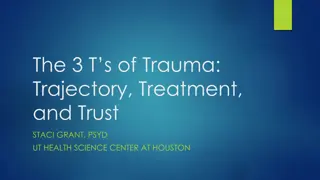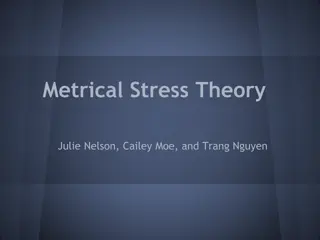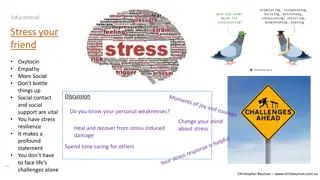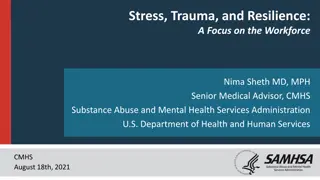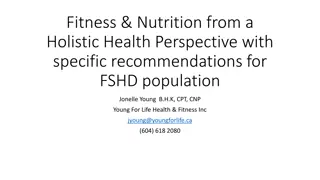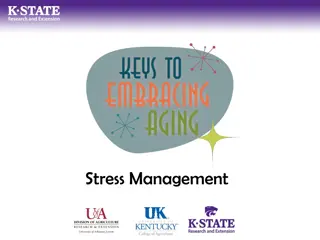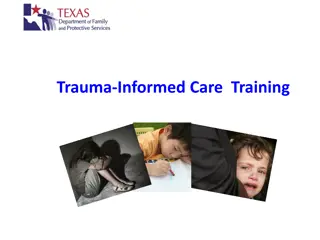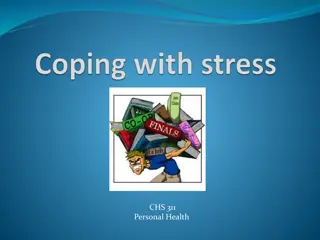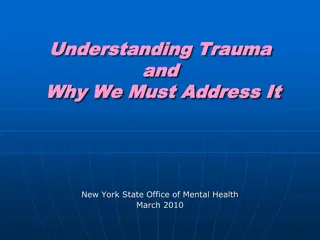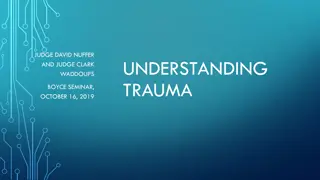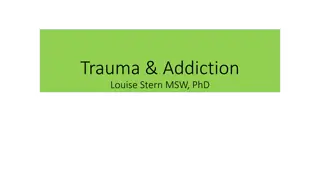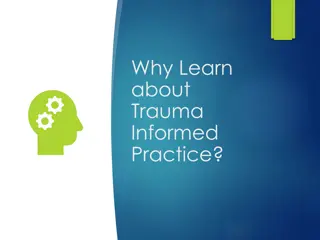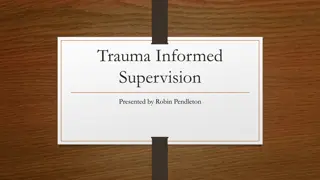Holistic Approach to Health and Well-being: Understanding Stress, Trauma, and Natural Solutions
Explore the holistic approach to health and well-being, delving into stress management, trauma release, and the benefits of natural medicine over conventional methods. Discover how chronic stress impacts the mind and body, and learn about the importance of addressing physical, mental, and social aspects for overall wellness. Meet Patricia Worby, a natural health practitioner, who shares her journey from illness to thriving health through holistic practices. Are you ready to transform your well-being and take charge of your health proactively?
Download Presentation

Please find below an Image/Link to download the presentation.
The content on the website is provided AS IS for your information and personal use only. It may not be sold, licensed, or shared on other websites without obtaining consent from the author. Download presentation by click this link. If you encounter any issues during the download, it is possible that the publisher has removed the file from their server.
E N D
Presentation Transcript
KEEP CALM AND GET HEALTHY Stress and the Mindbody solution; Releasing Trauma
About me Patricia Worby Biochemistry/pharmacology graduate, postgraduate health researcher. Despite a good diet I had asthma, allergies, depression,, migraines, skin cancer, then CFS/joint swelling.. Tried Chinese medicine in desperation - worked in 3 days! Changed my mind. Studied: Nutritional medicine, Clinical massage, Reiki, EFT, and Hypnotherapy. Now a natural health practitioner, wellbeing coach, specialist in chronic pain e.g. anxiety, back pain, auto- immune, CFS, Fibromyalgia, etc. www.alchemytherapies.co.uk
Today.. A holistic definition of health Stress and its effects on the body Trauma and pathological memory formation Psycho-sensory solutions Demo Bringing it all together; treating chronic disease & dysfunction Are you ready to transform your wellbeing?
Health definition Health is a state of complete physical, mental and social well-being, and not merely the absence of disease or infirmity. World Health Organization, 1948 Is a continuum not an all or nothing state. Is pro-active you need to do something to support the body to be healthy Is holistic mind, body and spirit are all involved. To properly heal must approach all 3.
Natural medicine vs conventional Western Natural Conventional Works with body to by strengthening natural defences i.e focus on health Target-driven approach e.g. magic bullet , etc. Focus on disease Deals with causes treat underlying root causes of disease using natural interventions on mind, body and spirit Deals with symptoms suppression or management via predominantly pharmaceutical and surgical means Empowers person to heal themselves; Treats person not the disease Gives over power to medical experts ; Treats disease regardless of person Requires commitment and taking responsibility for oneself Allows person to avoid responsibility and keep taking the tablets Good for chronic illness where disease is ideopathic* and multifactorial Good for acute illness e.g infectious disease with clear single target
Stress and the Body Stress is necessary it gives us drive and stimulation. It is excess chronic stress (cortisol) that is bad - very common Conscious stressors: Acute accident, sickness, divorce Unconscious stressors Chronic; -poor diet*negative beliefs, childhood programming, toxic thoughts, bad relationships, traumatic memory, negative emotions. Cause the most damage. Mediated by the autonomic nervous system *gut dysbiosis and leaky gut is endemic and has serious neurochemical effects via the gut depression (low serotonin)
Autonomic nervous system The Mind and Body link PNS SNS
The Stress Response activates the HPA axis of the sympathetic nervous system activate adrenals and thyroid A stressor is anything that takes the body out of homeostasis
The Anxiety Loop Anxiety/ Trauma memory Helplessness Illness/Pain/ Diagnosis Heavy metal poisoning Poor breathing
The Anxiety Loop; the Mind-Body connection So autonomic regulation is not a one-way street . Hormonal, neurotransmitter, neuropeptide regulation is ongoing and interdependent Every cell in your body contains neuropeptide* receptors and there is constant feedback between the organs (esp. the gut and your brain) Your cells know if you re happy or sad, what you think changes the cellular environment and vice versa Anxiety over symptoms keeps you stuck in sympathetic dominance The distinction between mind and body is artificial * Candace Pert, Molecules of Emotion
The Mind-Body connection; Neuro-peptides & transmitters A lot of neurotransmitters are in your gut e.g. serotonin so they are not just a brain body connection but a constant interplay. What triggers these to become imbalanced? Stress & trauma are major contributors threat to survival
Threat response When under threat an mammal will 1/ seek attachment (parasympathetic smart vagus) 2/ then escape (fight or flight) (HPA sympathetic nerve) and finally, if all else fails 3/ freeze response* (unmyelinated vagus reptilian parasympathetic Mediated by the autonomic nervous system which is unconscious (out of conscious awareness) Result of this if it is undischarged = trauma; an unresolved emotional threat to our survival *Children are particularly susceptible because they cannot flee and women are much more vulnerable to freeze
The Triune Brain: origin of unconscious threat subconscious - we are not aware of them; our survival mechanism 90% our function
Trauma: Definition Any unresolved event pathologically /permanently encoded causing emotion/symptoms in the present Can be physical (e.g. accident) or psychological e.g. abuse. Usually in childhood/young adulthood, linked by emotions & memory in the subconscious mind The meaning we attribute to the event not the severity of the event itself. So can be simply lack of love/support, feelings of abandonment, etc. Helplessness is the trigger. Trauma = Unresolved emotional memory
Traumatic memory formation Event No escape possible Thought/ belief e.g. I m not safe Sensation e.g. pounding heart, clock ticking, etc Emotion e.g. fear Stored in limbic system
The Emotional/ Mammalian Brain Where traumatic memory is stored
Why is trauma important? Any resulting event which triggers the same emotion will result in compounding and a re-experiencing of original emotion - overwhelm The more trauma you have the more cumulative emotional charge and the more disabling it will be. Affects personality and behaviour to a huge extent. Trauma is persistent, present and pervasive As it is stored in procedural memory it becomes a self- perpetuating cycle of internally generated subconscious stress which makes further trauma more likely - kindling Symptoms: depression, anxiety, panic attacks, poor eyesight, chronic pain (e.g back pain, TMJ, whiplash, Chronic Fatigue)*. *Trauma heightens sensitivity to physical pain neurologically (Howard 2000) and is associated with development of persistent (chronic) pain (Hart-Johnson & Green 2012)
Trauma = Unresolved Emotional memory Emotions are just feeling states made from neural connections. Most are habit-based. 1. Reactive: fear and defensive rage primitive, hardwired 2. Routine: happiness, surprise, anger, etc learned and fleeting in prefrontal cortex. 3. Reflective: require conscious thought e.g. shame, guilt, grief, jealousy, etc. Long-lived and can be traumatically encoded in the limbic system (amygdala and hippocampus)
Emotions are stressors Reactive and Reflective emotions do not diminish over time and produce chronic inescapable stress Appetitive needs e.g. attachment, food, water and sex promote drives which, if unmet, also cause stress. Addictions can therefore form. Both are evolutionary adaptations - survival Both affect memory, perception, thought and action via evaluation of the prefrontal cortex.
Nature of Emotions - Fear Can be motivating /enhance decision-making (diminish choices) and help memory retrieval (in short term) Most ancient emotion, hardwired. Conserved through evolution Survival mechanism to encode fear-producing memories to avoid predation Amygdala directs hippocampus to store and retrieve encoded memories for ready retrieval Indirect (learnt) information can also be encoded as trauma e.g if your mother says it s unsafe or she screams when she sees a spider i.e. a learned response
Traumatisation When an event happens before the hippocampus becomes active @age 3-4 are stored in procedural memory sense feeling, no cognition. Or emotionally charged implicit memories at a later stage you can t explain them Our behaviour is largely driven by these early events in procedural memory. If they are traumatised memories (i.e. with helplessness) they will be stored below conscious awareness and never fade
Consolidation A memory is stabilised by encoding of the memory trace consolidation of neural pathways In traumatisation the memory becomes permanentlyencoded in the amgydala i.e. when triggered by similar events, you re-experience the emotions as if they were today. Mediated by neurotransmitters glutamate, noradrenaline, cortisol and dopamine.
Trauma spectrum no trauma? Big T trauma life-threatening situation e.g. abuse, accident, unresolved loss, operation, etc Little t trauma many childhood experiences not always thought of as trauma at the time. Any emotionally charged experience which you interpret as inescapable e.g. your parents argue, you are blamed for something, bullying, etc Affects autonomic nervous system causing addictions, chronic pain, panic attacks, depression, insomnia (hypervigilance), irritability, procrastination, mutual dependency
Traumatising Event Event No escape possible Thought/ belief e.g. I m not safe Sensation e.g. pounding heart, clock ticking, etc Emotion e.g. fear All create negative cognition = belief about self at time of event NC is based on the emotion not on the data about the event itself. Therefore changing your thinking has limits.
Neurobiology of trauma Talking about it doesn t change the way the memory is stored. i.e. changing thinking ( cognitive restructuring not so effective for trauma). Need to work at the level of emotion, engage emotion to fire neural pathways These maladaptive memories are: Associative Cumulative Frozen (this is the difference with mal/adaptive) Painful overload! the past gets stored in the present But you may not be aware why it is unconscious
Why we struggle Body locked into fight and flight sympathetic dominance - mental & physical illness Feel stupid and embarrassed, weak, vulnerable, shame Have a low tolerance for frustration, slow changes Avoid things that trigger or re-enact rather than resolve Adopt learned helplessness lose faith we can change. Dissociate /freeze, not even in touch with emotions. We fear change. We dig our heals in resistance and carry on doing what we ve always done. Habit
The 3 pillars of treatment Psychotherapy: talking therapy which aims to understand origin of problem and in re- framing it to resolve it. Largely unsuccessful. Psychopharmacology: symptom suppression with pharmaceuticals. Limited success. Psychosensory: use of sensory stimulation to re-configure the brain s response to stressful memory. Moderate to Extraordinary success!
Psychosensory therapies A mindbody approach - does not distinguish between mental and physical response. We are both and they are intimately connected. We use the notion of neuroplasticity - constant re-wiring from birth onwards Two types, those that require: Memory activation prior to treatment (exposure therapies) and disrupt the connection between memory and emotion e.g EFT, EMDR - desensitisation Those that require the mind at rest (downregulate the stress response and its effect on information processing) e.g. massage, cranio-sacral, acupressure, mindfulness
Treatment: reactivation and re-consolidation Reactivation of these glutamate pathways during recall of memory makes these pathways alterable Neurons that fire together wire together If some form of havening then occurs during recall (touch or other sensory stimulation) the memory and its emotion can be dissociated extinction In order to heal: we need to make the unconscious conscious
Psychosensory approaches EMDR Eye movement desensitisation and Reprocessing- Bilateral stimulation EFT Emotional Freedom Technique tapping with self-affirmation Havening eye movements and self soothing Hypnotherapy e.g. Lightning process hypnotherapeutic intervention
EMDR used for: Panic Attacks Trauma Physical Abuse Anger Relationship issues Limiting beliefs Usually in combination with counselling, coaching or hypnotherapy
How does EMDR work? Several theories: Bilateral stimulation right and left hemispheres resolves and integrates memories in midbrain (limbic system). Like in REM sleep memory is pruned & digested. De-arousal of watching boring sensory stimuli right to left hemispheres via dopamine Change memories from implicit to explicit (you remember the association) Maladaptive links into adaptive network (facilitates insights), becomes less volatile But basically brings the cortex (frontal lobe) online and allows processing of the thought/emotion.
EMDR Is not hypnosis no trance state Is self (brain) directed figures out where it needs to go Is not just a technique (is a treatment modality) work within a framework/plan with a strategy Agree goals, predict results Teach and train afterwards Is mindfulness on steroids Like REM sleep processes ( prunes ) thoughts
Demo Full history assessment State change/safe place exercise Find targets/touchstone events/troubling memories Locate feeling in body rate SUDS* Bilateral stimulation (movement of therapists fingers left to right) focus on feelings, thoughts, memories Stop; what do you notice? Discuss. Take a deep breath. Start again repeat 3 or 4 times until SUDS = 0 Close-summarise. Bring in positive cognitions, summarise learning. *Subjective Units of Distress
EFT Emotional Freedom Technique Developed from treatment for victims of post-traumatic stress disorder PTSD energy psychology intervention which re-wires the brain Taps on the head and neck while focusing on the problem to be treated and repeating the set up phrase until the emotion around the thought it released. Has remarkable results!
EFT - how does it work? Even though I have this [state problem] I deeply and completely accept myself anyway Good for cravings, bad habits, exam nerves, weight loss and control, mild trauma, eyesight! Self-care for doing at home or before difficult situations Chase the problem other things will arise. How it works: Energy meridians gets the flow going again (Eastern) Neurological re-wiring (Ruden Western) Memory coding (linked with eye movements - Western)
Hypnotherapy Uses the power of your imagination to desensitise and rehearse difficult situations (unconscious processing 95% of brain function). Re-wire the brain by distracting the frontal lobe, reducing the thinking centres and allows reprogramming of emotional brain. Is profoundly powerful, experienced as relaxing but in fact is doing deep work NOT mind-control you are always conscious
References Peter Levine - In an Unspoken Voice, how the body releases trauma and restores Goodness' (latest) and 'Waking the Tiger' (his classic) James Alexander- The Hidden Psychology of Pain Robert Sapolsky - Why Zebras don't get Ulcers Robert Scaer - The Trauma Spectrum Ronald Ruden - When the Past is Always present Dr John Sarno - The Mindbody Prescription Dr James Alexander -The Hidden Psychology of Pain Prof. Martin Seligman - Learned optimism & What you can change and what you can t + for an exhaustive account of the stress response: http://physrev.physiology.org/content/87/3/873
Thank you for listening Thanks to all my clients, who are my best teachers.. Clinics Peartree (home) Central (Orchard therapies, London Road) Portswood (Spring Chiropractic) Patricia Worby MSc. ACMT, HPD, GHR @patriciaworby Patricia Worby Holistic Health/Alchemy






